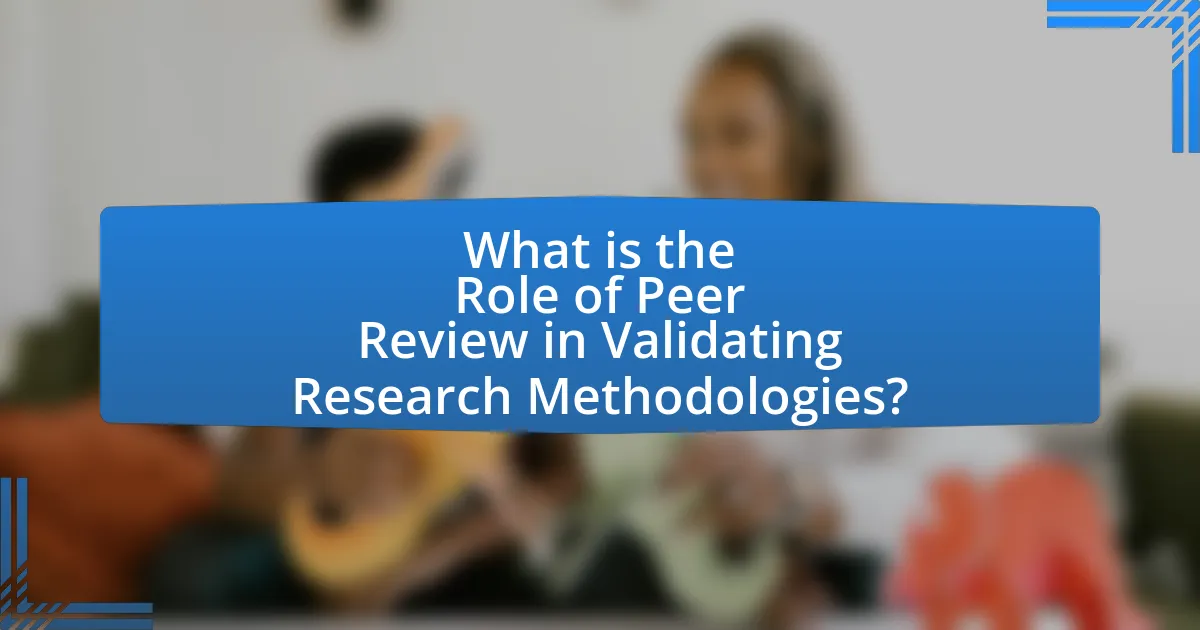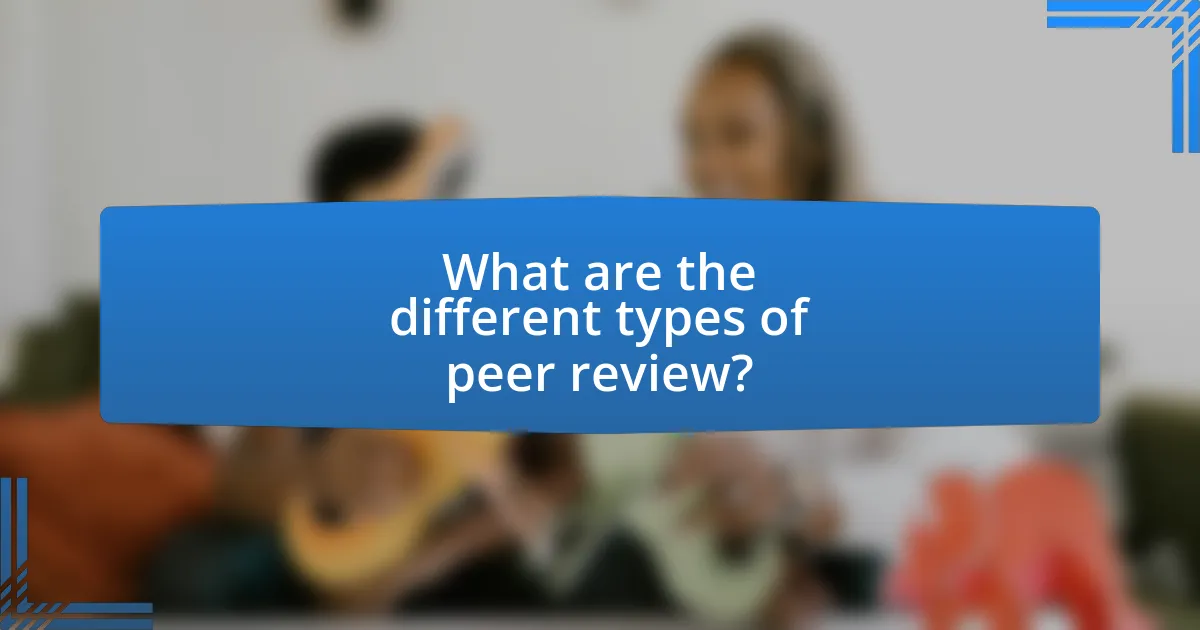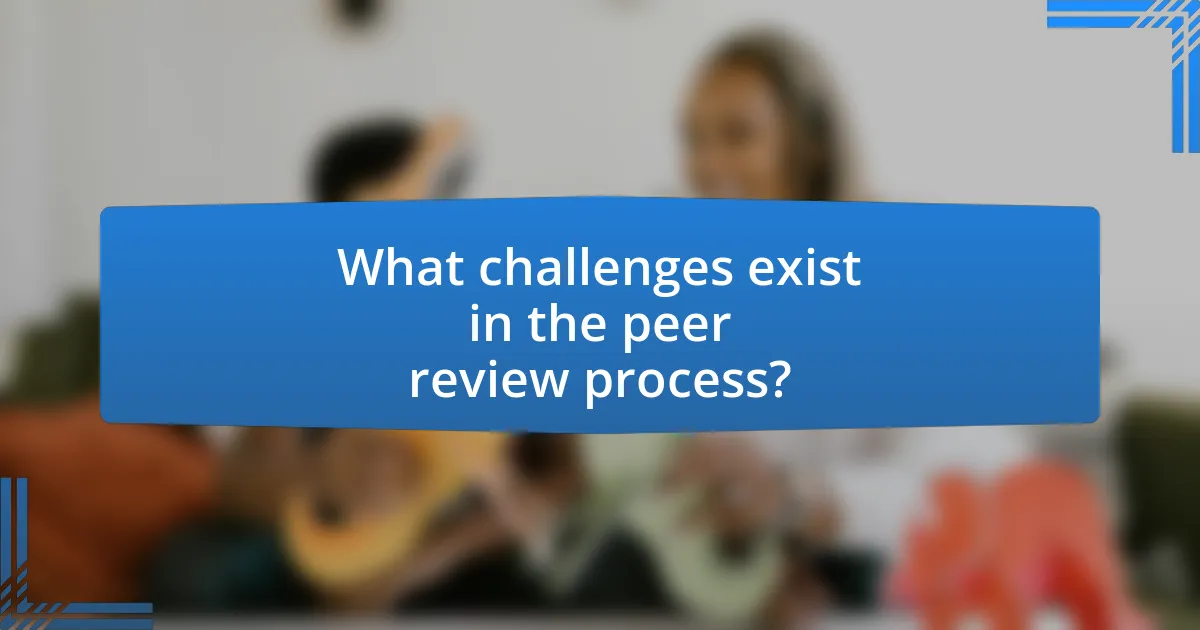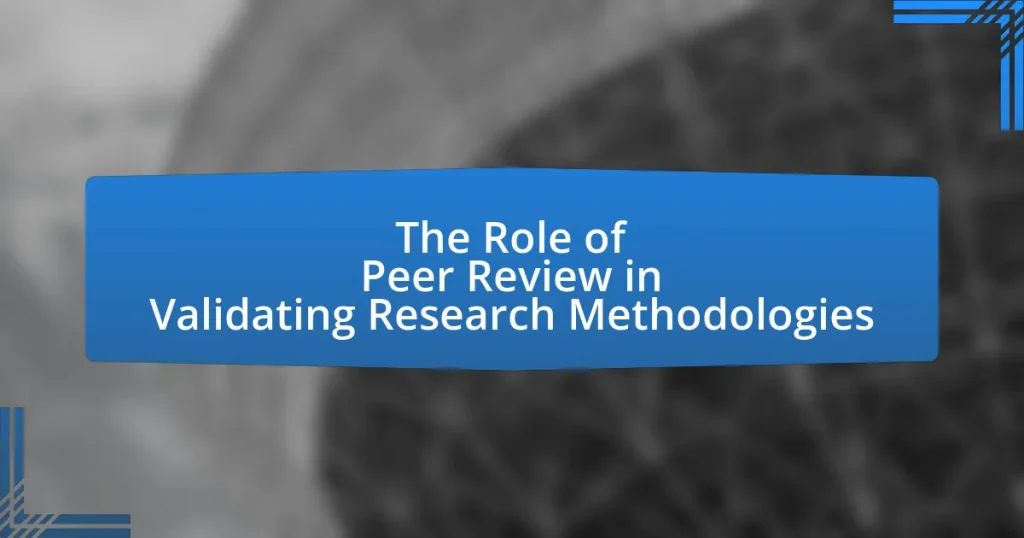Peer review is a critical process in validating research methodologies, ensuring that studies are rigorously evaluated by experts before publication. This article examines the role of peer review in enhancing the credibility and reliability of research findings, highlighting its impact on the acceptance and quality of scholarly work. Key elements of the peer review process, including different types such as single-blind, double-blind, and open peer review, are discussed, along with the qualifications required for reviewers and the challenges faced in the process. The article also explores strategies to mitigate bias, improve peer review standards, and the importance of transparency in fostering trust within the research community.

What is the Role of Peer Review in Validating Research Methodologies?
Peer review plays a critical role in validating research methodologies by ensuring that studies are rigorously evaluated by experts in the field before publication. This evaluation process helps identify potential flaws, biases, and methodological weaknesses, thereby enhancing the credibility and reliability of the research findings. For instance, a study published in the journal “Nature” highlighted that peer-reviewed articles are more likely to be cited and have a greater impact on the scientific community, indicating that the peer review process contributes to the overall quality and acceptance of research methodologies.
How does peer review contribute to the credibility of research methodologies?
Peer review enhances the credibility of research methodologies by subjecting them to rigorous evaluation by experts in the field. This process ensures that the methodologies are scrutinized for validity, reliability, and adherence to ethical standards. Studies have shown that peer-reviewed research is more likely to be methodologically sound, as evidenced by a 2016 analysis published in the journal “PLOS ONE,” which found that peer-reviewed articles had a significantly lower rate of methodological flaws compared to non-peer-reviewed studies. Thus, the peer review process acts as a quality control mechanism, reinforcing the trustworthiness of research methodologies.
What are the key elements of the peer review process?
The key elements of the peer review process include the submission of a manuscript, evaluation by experts in the field, feedback provision, and a final decision on publication. Initially, authors submit their research to a journal, where editors assess its suitability for review. Subsequently, the manuscript is sent to independent reviewers who evaluate its quality, validity, and significance. Reviewers provide constructive feedback, which may lead to revisions by the authors. Finally, based on the reviewers’ recommendations, the editor makes a decision to accept, reject, or request further revisions before publication. This structured process ensures that published research meets established academic standards and contributes to the body of knowledge.
How do reviewers assess the validity of research methodologies?
Reviewers assess the validity of research methodologies by evaluating the appropriateness, rigor, and transparency of the methods used. They examine whether the chosen methodology aligns with the research questions and objectives, ensuring that it is suitable for the study’s context. Reviewers also look for detailed descriptions of the procedures, sample sizes, and statistical analyses to confirm that the methods can be replicated and yield reliable results. Additionally, they consider the ethical implications of the methodology, ensuring that it adheres to established ethical standards in research. This thorough evaluation process helps ensure that the research findings are credible and can contribute meaningfully to the field.
Why is peer review essential in the research community?
Peer review is essential in the research community because it ensures the quality, credibility, and validity of scholarly work. This process involves experts evaluating research before publication, which helps identify errors, biases, and methodological flaws. According to a study published in the journal “Nature,” peer-reviewed articles are more likely to be cited and recognized as credible compared to non-peer-reviewed work, highlighting the importance of this validation process in maintaining scientific integrity.
What impact does peer review have on research quality?
Peer review significantly enhances research quality by ensuring that studies undergo rigorous evaluation by experts in the field before publication. This process helps identify methodological flaws, biases, and gaps in the research, leading to improved accuracy and reliability of findings. Studies have shown that peer-reviewed articles are more likely to be cited and have a higher impact on their respective fields, indicating that the peer review process contributes to the credibility and scholarly value of research. For instance, a study published in the journal “PLOS ONE” found that peer-reviewed articles had a citation advantage over non-peer-reviewed articles, underscoring the importance of this evaluative process in maintaining high research standards.
How does peer review influence the acceptance of research findings?
Peer review significantly influences the acceptance of research findings by providing a critical evaluation process that assesses the validity, reliability, and originality of the research. This evaluation is conducted by experts in the field who scrutinize the methodology, data analysis, and conclusions drawn by the authors. Studies have shown that peer-reviewed articles are more likely to be accepted for publication, as they undergo rigorous scrutiny that enhances their credibility. For instance, a study published in the journal “PLOS ONE” found that peer-reviewed research is perceived as more trustworthy by both the academic community and the public, leading to higher citation rates and greater impact. Thus, the peer review process serves as a gatekeeping mechanism that ensures only high-quality research findings are disseminated, ultimately shaping the scientific discourse.

What are the different types of peer review?
The different types of peer review are single-blind, double-blind, and open peer review. In single-blind peer review, the reviewers know the identity of the authors, but the authors do not know the identities of the reviewers. This method is commonly used in many academic journals to maintain a level of anonymity for reviewers while allowing them to provide feedback based on their expertise. In double-blind peer review, both the authors and the reviewers remain anonymous to each other, which aims to reduce bias and ensure that the evaluation is based solely on the quality of the work. Open peer review, on the other hand, involves transparency where both the authors and reviewers are known to each other, and the reviews are often published alongside the article. This approach promotes accountability and can enhance the quality of the review process. Each type of peer review serves to validate research methodologies by ensuring that the work meets the standards of the academic community.
How do single-blind, double-blind, and open peer review differ?
Single-blind, double-blind, and open peer review differ primarily in the visibility of reviewer identities and author identities during the review process. In single-blind peer review, reviewers know the authors’ identities, but authors do not know who the reviewers are. This can lead to potential bias from reviewers who may be influenced by the authors’ reputations. In double-blind peer review, both the reviewers and authors remain anonymous to each other, which aims to reduce bias and promote impartiality in the evaluation process. Open peer review, on the other hand, allows both authors and reviewers to know each other’s identities, fostering transparency and accountability, but it may also introduce bias due to the potential for personal relationships to influence the review. Each method has implications for the integrity and fairness of the peer review process, impacting the validation of research methodologies.
What are the advantages and disadvantages of each peer review type?
The advantages and disadvantages of each peer review type include single-blind, double-blind, and open peer review. Single-blind peer review allows reviewers to remain anonymous, which can encourage honest feedback but may lead to bias if reviewers feel less accountable. Double-blind peer review conceals both authors’ and reviewers’ identities, reducing bias and promoting fairness, but it can be challenging to implement effectively. Open peer review, where both authors and reviewers are known, fosters transparency and accountability, yet it may discourage critical feedback due to fear of reputational damage. Each type has its unique strengths and weaknesses that impact the integrity and quality of the review process.
How does the choice of peer review type affect research validation?
The choice of peer review type significantly affects research validation by influencing the rigor and transparency of the evaluation process. Different peer review types, such as single-blind, double-blind, and open peer review, each have distinct implications for how research is scrutinized. For instance, double-blind peer review, where both reviewers and authors remain anonymous, can reduce bias and promote objectivity, thereby enhancing the credibility of the validation process. Conversely, single-blind peer review, where reviewers know the authors’ identities, may introduce bias, potentially compromising the integrity of the validation. Studies have shown that open peer review, which allows for public scrutiny and feedback, can increase accountability and improve the quality of research by fostering a collaborative environment. Thus, the type of peer review employed directly impacts the thoroughness and reliability of research validation.
What role do peer reviewers play in the research process?
Peer reviewers play a critical role in the research process by evaluating the quality, validity, and originality of submitted manuscripts before publication. Their assessments help ensure that research methodologies are sound, findings are credible, and conclusions are justified. This process enhances the integrity of academic publishing by identifying potential flaws, biases, or gaps in the research, thereby contributing to the overall reliability of scientific literature. Studies indicate that peer review can significantly improve the quality of published research, as evidenced by a survey conducted by the National Academy of Sciences, which found that 90% of researchers believe peer review is essential for maintaining research quality.
What qualifications should peer reviewers possess?
Peer reviewers should possess advanced degrees in their field of expertise, typically a PhD or equivalent, to ensure they have the necessary knowledge and understanding of the subject matter. This academic background enables them to critically evaluate the research methodologies and findings presented in submissions. Additionally, peer reviewers should have relevant research experience, which allows them to assess the validity and reliability of the methodologies used in the studies they review. Their familiarity with current trends and standards in research further enhances their ability to provide constructive feedback. According to a study published in the journal “Nature,” effective peer reviewers are often those who have published extensively in their field, as this experience equips them with insights into the peer review process and the expectations of high-quality research.
How do peer reviewers provide constructive feedback?
Peer reviewers provide constructive feedback by critically evaluating the research methodology, clarity, and significance of the findings presented in a manuscript. They assess the validity of the research design, data analysis, and interpretation of results, ensuring that the study adheres to established scientific standards. For instance, a study published in the journal “Nature” highlighted that effective peer review enhances the quality of research by identifying methodological flaws and suggesting improvements, which ultimately strengthens the overall contribution to the field. This process not only aids authors in refining their work but also upholds the integrity of the scientific literature.

What challenges exist in the peer review process?
The peer review process faces several challenges, including bias, inconsistency, and lack of transparency. Bias can arise from reviewers’ personal beliefs or affiliations, potentially skewing the evaluation of research. Inconsistency occurs when different reviewers provide varying assessments of the same manuscript, leading to unpredictable outcomes. Lack of transparency in the process can hinder accountability, as authors may not know the criteria used for evaluation or the identities of their reviewers. These challenges can undermine the reliability and credibility of the peer review system, impacting the validation of research methodologies.
How can biases affect peer review outcomes?
Biases can significantly skew peer review outcomes by influencing reviewers’ evaluations of research quality and validity. For instance, confirmation bias may lead reviewers to favor studies that align with their pre-existing beliefs, while gender or racial biases can result in unfair assessments based on the authors’ identities rather than the research itself. A study published in the journal “Nature” found that papers authored by women were less likely to be accepted than those by men, highlighting the impact of gender bias in peer review processes. Such biases compromise the integrity of the peer review system, ultimately affecting the credibility of published research.
What strategies can mitigate bias in peer review?
Implementing double-blind peer review is a key strategy to mitigate bias in peer review. This approach conceals the identities of both reviewers and authors, reducing the influence of personal biases related to gender, affiliation, or reputation. Research indicates that double-blind reviews can lead to more equitable evaluations, as shown in a study published in the journal “Nature” by Budden et al. (2008), which found that female authors benefited from this anonymity, resulting in a more balanced acceptance rate compared to single-blind reviews. Additionally, establishing clear and standardized review criteria can further minimize subjective judgments, ensuring that all submissions are evaluated based on the same metrics.
How does the pressure to publish influence peer review quality?
The pressure to publish negatively influences peer review quality by incentivizing rapid submissions over thorough evaluations. Researchers facing this pressure may prioritize quantity of publications, leading to superficial reviews that lack depth and critical analysis. A study published in the journal “Nature” by van Dijk et al. (2020) found that increased publication pressure correlates with a decline in the rigor of peer reviews, as reviewers may rush through evaluations to meet deadlines. This trend undermines the peer review process, compromising the integrity and reliability of published research.
What are the implications of poor peer review practices?
Poor peer review practices can lead to the dissemination of flawed research, undermining the integrity of scientific literature. When peer review is inadequate, studies may go unchallenged, allowing erroneous methodologies and conclusions to influence future research and policy decisions. For instance, a study published in the journal “Nature” highlighted that approximately 30% of published research contains significant methodological flaws due to insufficient peer review. This can result in wasted resources, misinformed public health policies, and a loss of trust in scientific findings. Furthermore, poor peer review can hinder the advancement of knowledge by allowing subpar studies to overshadow rigorous, high-quality research.
How can flawed peer review lead to the dissemination of unreliable research?
Flawed peer review can lead to the dissemination of unreliable research by allowing studies with methodological errors or biases to be published without adequate scrutiny. When reviewers fail to critically assess the research design, data analysis, or interpretation of results, they may inadvertently endorse findings that lack validity. For instance, a study published in the journal “Nature” highlighted that nearly 50% of peer-reviewed articles contained significant methodological flaws, which can mislead subsequent research and policy decisions. This lack of rigorous evaluation contributes to the propagation of misinformation within the scientific community and undermines the integrity of the research process.
What steps can be taken to improve peer review standards?
To improve peer review standards, journals should implement a transparent review process that includes clear guidelines for reviewers. Establishing these guidelines ensures that reviewers understand the expectations and criteria for evaluating submissions, which can lead to more consistent and fair assessments. Research indicates that transparency in the review process enhances accountability and trust in published research, as seen in studies like “The Effect of Open Peer Review on the Quality of Reviews” published in PLOS ONE, which found that open peer review improved the quality of feedback provided. Additionally, training programs for reviewers can be developed to enhance their skills in providing constructive criticism, further elevating the quality of the review process.
What best practices can researchers follow to enhance peer review outcomes?
Researchers can enhance peer review outcomes by ensuring clarity and transparency in their submissions. Clear writing helps reviewers understand the research objectives, methodology, and findings, which facilitates a more effective evaluation process. Transparency in data sharing and methodology allows reviewers to assess the validity and reliability of the research, leading to more constructive feedback. Additionally, providing a comprehensive literature review contextualizes the research within existing studies, which can help reviewers appreciate its significance. Engaging with the peer review process by responding to feedback and making necessary revisions demonstrates a commitment to quality, further improving the chances of a favorable review outcome.
How can researchers effectively respond to peer review feedback?
Researchers can effectively respond to peer review feedback by systematically addressing each comment and suggestion provided by reviewers. This involves carefully analyzing the feedback, categorizing it into major and minor points, and drafting a detailed response that explains how the feedback has been incorporated or why certain suggestions may not be feasible. For instance, a study published in the journal “Nature” highlights that clear communication and transparency in addressing reviewer comments can significantly enhance the chances of manuscript acceptance. By providing specific examples of changes made or justifications for maintaining original content, researchers demonstrate their engagement with the review process and their commitment to improving the quality of their work.
What role does transparency play in the peer review process?
Transparency is crucial in the peer review process as it fosters trust, accountability, and integrity in scholarly communication. By making the review process visible, stakeholders can assess the quality and rigor of the evaluation, ensuring that the research meets established standards. Studies indicate that transparency can reduce biases and conflicts of interest, as reviewers are more likely to provide objective feedback when their identities and evaluations are disclosed. For instance, a 2018 study published in the journal “Nature” found that open peer review, where reviewer comments and identities are shared, led to more constructive criticism and improved manuscript quality. Thus, transparency enhances the credibility of the peer review process and ultimately strengthens the validity of research methodologies.


